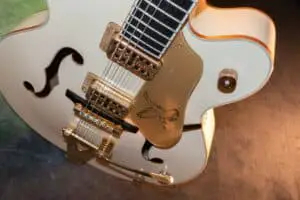
The guitar has blessed the world with so many great melodies and legends. The richness and versatility of its sound have led it to dominate almost all genres of music.
It might be easier just to put a blanket over all guitar sounds and call it a day, but if you listen closely, you’ll notice the differences in the guitar rhythms.
From the hard-hitting melodies of a rock metal band to the soothing euphonies of a classical guitarist, the guitar’s versatility is truly incredible. This is possible thanks to the different types of guitars available.
So how many types of guitars are there?
Generally, there are four major types of modern guitars; the classical guitar that was made for classical music, the acoustic guitar that is used for most popular music we hear today, the electric guitar that uses wire-wound magnets to amplify its sound, and the bass guitar that’s perfect for low bass rhythm sounds.
However, there’s more to know about these different guitars, and here, we’ll give you a brief history of each of them, plus the type of sound associated with each.
Types of Guitars
Many different types of guitars are available on the market today, and each has unique features and capabilities. Let’s take a look at some of the popular types of guitars and their key features.
Acoustic Guitar
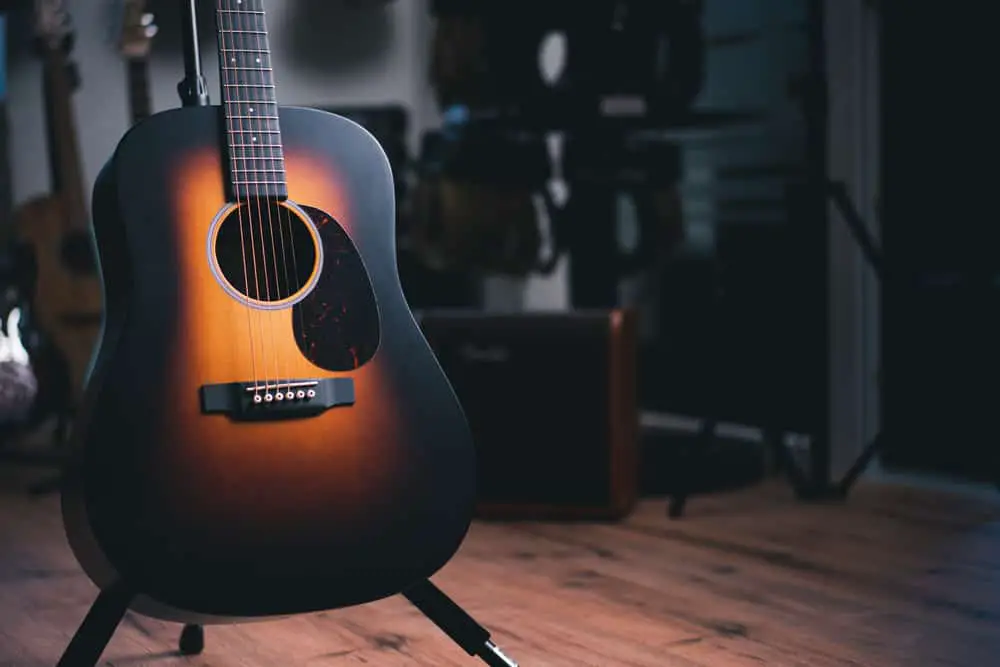
Although there’s uncertainty about the true origins of the Acoustic guitar, it is generally believed that they originated in Spain. Historians believe it to be an offspring of a medieval instrument called the “Guitarra Latina.”
However, Antonio Torres Jurado is credited with the current structure and form of the modern acoustic guitar we know today. It was formerly referred to as just the guitar but saw a name change after the invention of other types of guitar.
Characteristics
A typical acoustic guitar has a hollow wooden body. The most common wood used for guitars includes rosewood, mahogany, maple, and spruce (mainly used for guitar tops).
They generally have six strings held to their body by a nut and a saddle. As for the strings, they are typically made from tin-plated steel.
Sound
The acoustic guitar sound is influenced by its dimensions and the type of wood used in manufacturing.
When you pluck the strings, they cause a vibration that is transmitted down to the saddle and into the guitar’s soundboard. These vibrations are then transmitted throughout the guitar’s top, back, and sides.
Due to the movement of these vibrations, they start to resonate through the guitar’s air and form the soothing sound we hear from the sound hole.
Ease of Play
The acoustic guitar is the most popular guitar in the world and the most preferred by beginners. Roughly 22 million acoustic guitars have been sold in the US alone since 2005, with brands like Fender, Taylor, and Martin contributing to the billion-dollar industry.
Lastly, If you’re a beginner looking to get into guitars, you should have your eyes on the acoustic guitar. They are by far the most versatile in terms of sound and genre. Acoustic guitars are also the easiest to learn, and you’ll understand the basics of guitars faster when you start with an acoustic.
Classical Guitar
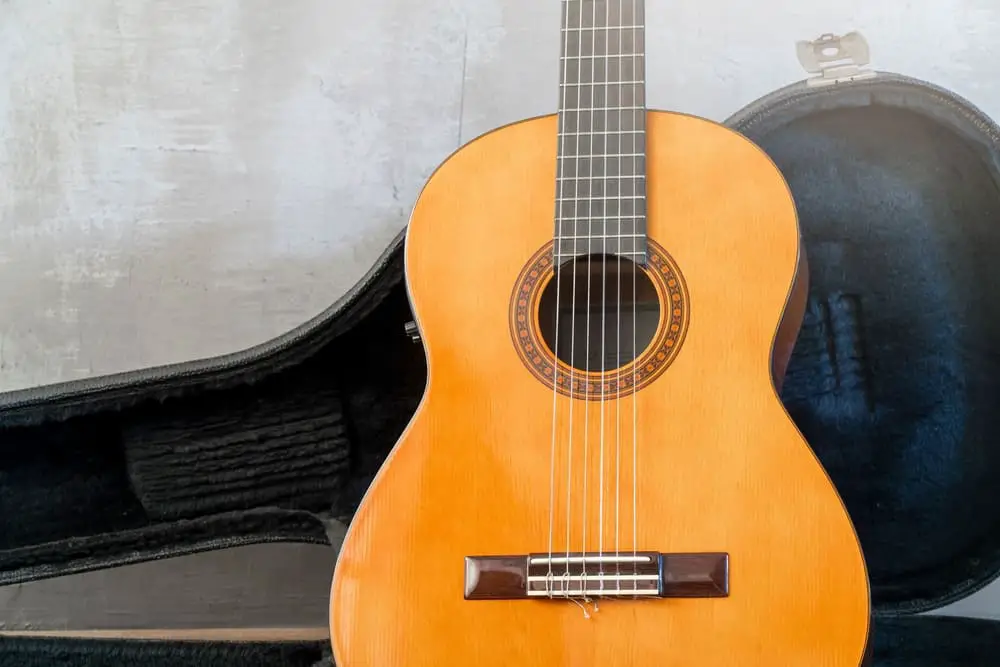
The classical guitar is one of the oldest members of the guitar family. It precedes the acoustic and electric guitar and has existed for centuries.
Characteristics
Many might exclude the classical guitar from the list of guitar types, citing its similarities with the acoustic guitar. They are not entirely wrong; the two guitars share a visual resemblance.
It might be hard to differentiate between them as they both have six tuning pegs, a sound hole, and six strings.
However, there are lots of differences between the two. For instance, classical guitar’s necks are wider than that of acoustics. As a result, the distance between the strings of a classical guitar is greater than that of an acoustic guitar.
Another significant difference between the two guitars is their strings. Classical guitars use nylon strings, while acoustic guitars use steel.
Sound
The nylon strings are the reason for the disparities in acoustic and classical guitar sounds. Nylon strings are heavy and thick, allowing them to produce soft and mellow sounds. The thickness of the strings also gives them a soft feel on the fingers, making them perfect for beginners.
The classical guitar sound production system follows that of the acoustic guitar. You can also modify them with external pickups that’ll allow the guitar sound to be heard from a louder speaker.
Ease of Play
The downside to this guitar is its lack of versatility. Unless you’re into Flamenco, classical, or Spanish music, you might probably be better off sticking to an acoustic guitar.
Electric Guitar
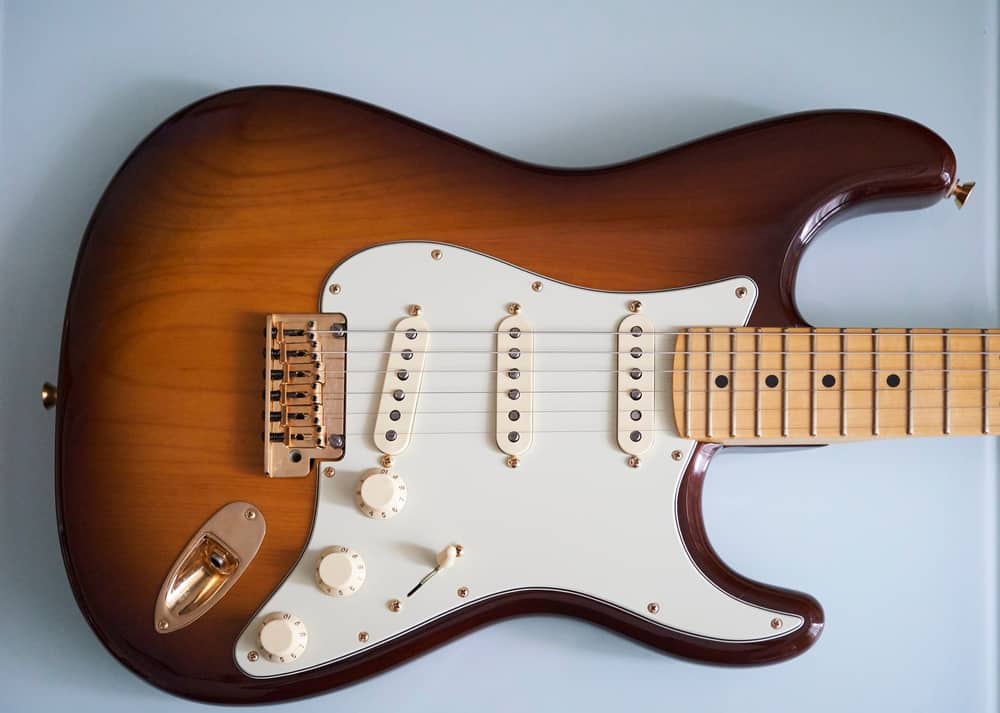
The desire to play single-note guitar solos as part of an ensemble band prompted the invention of the electric guitar in 1932. Orchestras and bands were getting bigger, so guitarists needed louder guitars to fully capture their musical performance.
While some manufacturers tried to make larger guitar bodies, others experimented on metal bodies. A select few decided to try out electronic amplification, and in 1931, the Frying Pan, the world’s first electric guitar, was invented by George Beauchamp.
Les Paul, Charlie Christian, and Lonnie Johnson were amongst the early proponents of the electric guitar. By the 50s, the electric guitar had made its way to the heart of popular music, and everybody was making music with one.
Today, the electric guitar has evolved into sounds covering different genres like rock, pop, jazz, blues, and country.
Gibson, Ibanez, Epiphone, and Fender are some of the most common electric guitar brands.
Characteristics
Acoustic and electric guitars share similarities in the number of strings (six), tuning pegs (also six), and type of wood used in production.
The electric guitar has a solid body to prevent unwanted feedback and the wolf tone typical in acoustic guitars. Its six strings are mostly made from nickel-plated steel wires and cores.
Sound
Unlike the acoustic guitar, which relies on the guitar’s dimension and wood type to produce sound, the electric guitar’s sound is influenced by the quality of pickups, amplifiers, and speakers.
The electric guitar’s sound also comes from strings’ vibration, only this time, the vibrations are converted to electric signals by the guitar’s pickups. These signals are sent to an amplifier through a cable, and the amplifier converts them to the sounds we hear on the speaker.
Ease of Play
Lastly, the lightness and comfortability of the electric guitar strings make them easier to play, especially for beginners. Unfortunately, mastering them can take a long while, and they’re not ideal for beginners trying to understand the concept of the guitar.
Bass Guitar
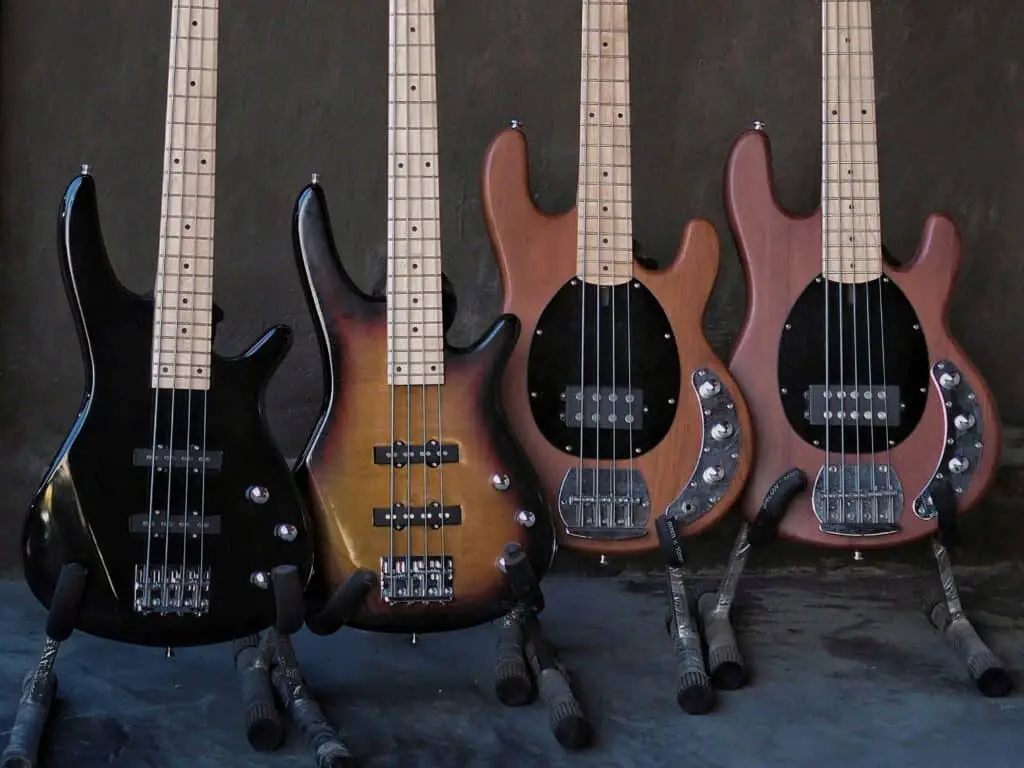
Before the bass guitar, the double bass was the most used bass instrument in music. Even after Paul Tutmarc’s first electric guitar was released in the 30s, the instrument didn’t gain popularity till George Fullerton and Leo Fender started mass producing it in the 50s.
Fender Bass’s became a favorite for many traveling artists. Because when compared to the bass instrument that was common at the time, Fender Bass was light and could easily be transported.
Also, due to it being an electric bass, there were fewer wolf tones and useless audio feedback. The installed frets also allowed bassists to play in tune for more extended periods.
Characteristics
The bass guitar is also called the electric bass and has the physical appearance of an acoustic or electric guitar. However, the bass guitar has a longer scale length and neck, plus they mostly come with only four strings.
Bass guitar’s bodies are generally made from light materials. The standard type of wood used is mahogany, ash, and alder. Their strings are made from nickel-wrapped wired steel cores.
Sound
The electric and bass guitars are similar in many ways, including sound production. When the bass strings are plucked, its pickups convert the vibrations generated into electric signals.
The attached cables now transfer these signals to amplifiers, converting them to the pleasing low-frequency sound we hear from the speakers.
Ease of Play
You should probably stay away from the bass guitars if you’re new to the guitar. Although some might argue that being four-stringed makes learning easier, that’s not entirely true.
For starters, the neck is longer than that of standard guitars. They also have heavy and thick stings, making it harder for the fingers to pluck them.
The bass guitar is one of the heaviest members of the guitar family, and you might find it difficult to carry around.
The Bottom Line
Even after deciding to learn the guitar, choosing a particular type to learn can be tiring. We don’t blame you, though, the guitar family is extensive, and there are many wonderful instruments to choose from.
However, there are four major types of guitars: the acoustic guitar, the electric guitar, the bass guitar, and the classical guitar.
Even though they all share similarities, distinct qualities separate them. Choosing one from the four will largely depend on the genre of music you want to learn, but it’s generally advisable to start with the acoustic guitar.
Frequently Asked Questions
Generally, Acoustic guitars are believed to be the best due to their playability and sound. They are also ideal for beginners looking to understand the basic concepts of the guitar.
Acoustic guitars are the most used guitars around the world. They are followed by the electric and bass guitar, respectively.

